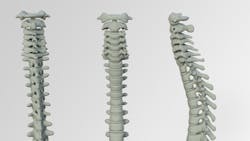Study finds similar short-term outcomes with common, minimally-invasive spine procedures
A study comparing short-term outcomes of minimally invasive (MI) lumbar decompression surgery to MI lumbar spine fusion surgery found no statistically significant difference in the amount of time patients needed to return to work.
Researchers at Hospital for Special Surgery (HSS) in New York City also found that patients in both groups were able to discontinue narcotic pain medication within one week following surgery. Patients in the MI lumbar decompression group resumed driving four days sooner than those in the MI spine fusion group.
The findings are especially noteworthy, according to Sheeraz Qureshi, MD, MBA, HSS spine surgeon and the study’s senior investigator, because a standard open spinal fusion generally entails a much longer recovery and slower return to activities than a standard lumbar decompression. This study is available online as part of the AAOS 2020 Virtual Education Experience.
“Our study is the first of its kind to look at return to activities and discontinuation of narcotic pain medication after single-level lumbar decompression or single-level lumbar spine fusion performed with a minimally invasive technique,” said Dr. Qureshi, who is also the Patty and Jay Baker Endowed Chair in Minimally Invasive Spine Surgery at HSS. “In our study, all the patients in both groups were able to resume driving and return to work within three weeks of surgery. When you compare this time frame to that of standard open spinal fusion surgery, it’s really striking. Patients having a standard spinal fusion could take six months or longer for a full recovery.”
Degenerative conditions of the lumbar (lower) spine, such as a herniated disc or spinal stenosis, are common causes of pain and disability. Patients may consider surgery when conservative treatments such as medication and physical therapy fail to provide relief.
Lumbar decompression surgery is performed to relieve pain by removing a small section of bone or part of a herniated, or bulging, disc that is pressing on a nerve. Spinal fusion, a more extensive surgery, is performed to eliminate painful motion or to stabilize and strengthen the spine. Surgeons join two or more vertebrae together, sometimes using screws and connecting rods.
Over the past few years, minimally invasive spine surgery has gained in acceptance and popularity, Dr. Qureshi said. The technique uses smaller incisions than standard spine surgery and aims to minimize damage to nearby muscles and other tissues.
The study included patients who had elective one-level MI lumbar decompression or one-level MI lumbar spine fusion between April 2017 and July 2019 by a single orthopedic surgeon at HSS. Patients included in the analysis were driving or working before surgery or were administered narcotic pain medication post-operatively.
Investigators found that it took the 117 decompression patients a median of three days to discontinue narcotic pain medication, while it took a median of seven days for the 51 spinal fusion patients. With respect to driving, the analysis included the number of patients who were driving pre-operatively and returned to driving after surgery. It took 88 decompression patients a median of 14 days to resume driving, while the 45 fusion patients took 18 days.
Researchers found no statistically significant difference in the time patients in each group needed to return to work. To explain that finding, Dr. Qureshi noted that both MI decompression and MI fusion utilize the same type of initial approach to reach the spine with approximately the same size incisions. There is significantly less tissue damage compared to standard open spine surgery, which may explain the similar rate of return to work.
With respect to discontinuing narcotics, although minimally invasive spine surgeries reduce incision sizes and tissue damage overall compared to open spine procedures, MI fusions are still more extensive surgeries, so pain medication may be needed for a longer period of time, according to Dr. Qureshi. Concerning driving, he says it’s possible that fusion patients take longer to recover their driving reaction times compared to patients who have decompression surgery.
